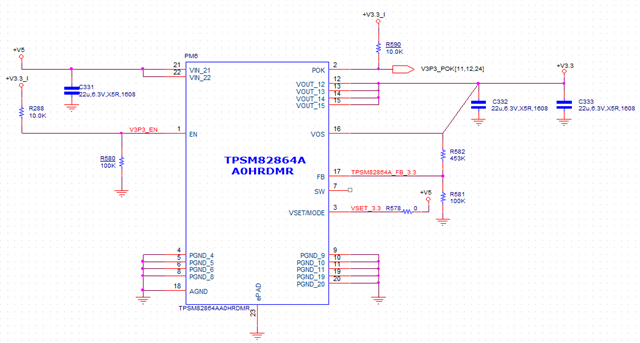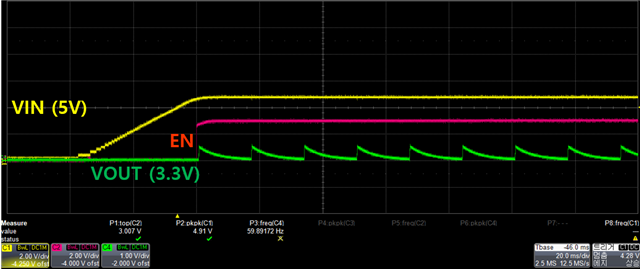Other Parts Discussed in Thread: TPSM82810, TPSM82813
Tool/software:
Hi.
I designed a 5V to 3.3V circuit using TPSM82864AA0HRDMR.
I have a problem with the 3.3V output waveform.
What should I check?


Best Regards
Tool/software:
Hi.
I designed a 5V to 3.3V circuit using TPSM82864AA0HRDMR.
I have a problem with the 3.3V output waveform.
What should I check?


Best Regards
Hello WSJ,
thanks for reaching out in E2E.
The schematic is looking OK.
The waveform is indicating some HICCUP Short-Circuit Protection scenario. You should check for too high output current. Excessive current can occur with a heavy load, shorted output circuit condition or when using huge bulk caps in the attached circuitry. The TPSM82864A is trying to restart ca. every 16ms as long as the over-current condition remains.
Let me know if you have any questions.
Best regards,
Andreas.
Hello Andreas
Thank you for your answer.
This circuit is used in FPGA board, and the output voltage is used for VCCO 3.3V of FPGA, NOR flash, etc..
The expected current consumption of the output voltage is up to 1.4A. I modified the discontinued Intel EN6337QI (3A) to TPSM82864A (4A). The board worked fine before the modification, so I expect the current consumption to be good.
I checked if the voltage is shorted before powering the board, there was no short.
Is there a way to disable the HICCUP short-circuit protection?
What else should I check?
Best Regards,
WSJ
Hello Andreas
I used two 22uF capacitors on the output of the TPSM82864AA0HRDMR circuit.
However, including the bypass capacitors of the devices that use that output voltage and the large capacitors on the entire board, the total capacitance is 1900~2000uF.
Is this a problem?
What is the appropriate capacitance?
Best Regards,
WSJ
Hello WSJ,
thanks for the update.
Yes, I think the huge total output capacitance is causing the problem.
The TPSM82864A can support up to 150 μF and the HICCUP protection cannot be turned off.
The TPSM82813 or TPSM82810 would be alternative devices, which can support up to 470 μF output capacitance and their over-current protection behaves more like a current clamp. Also the soft start time is adjustable for these devices. So it would be possible to start slower and avoid high inrush current.
Let em know if you have any questions.
Best regards,
Andreas.
Hi,
There was no feedback since a while, so I assume this tread is resolved and can be closed. You can still reply to this thread after it is closed, or you can create a new thread.
Best Regards,
Andreas.
Hello, Andreas.
I'm testing from 5V to 1.8V using the same circuit I asked about above, the TPSM82864AA0HRDMR.
The total capacitance for the 1.8V output voltage is approximately 2150uF.
According to the equation "Iinrush = C x dV/dt", Iinrush is 3.87A.
The calculated inrush current is below the FET current limit of the TPSM82864AA0HRDMR (4.5A?), so HICCUP mode should not be enabled. However, the actual output voltage waveform appears to be in HICCUP mode. (Removing the 400uF capacitance ensures a normal 1.8V output voltage.)
What should I look for?
Best regards,
WSJ
Hi WSJ,
Andreas is on vacation, so I'm answering on his behalf.
In addition to charging the output caps during startup, the load current also needs to be supplied. Both these are most likely causing it to exceed current limit.
TPSM82866AA0HRDMR is a p2p 6A version.
However it is still not recommended to exceed 150uF max COUT for this device as it is internally compensated to handle only that amount of output cap.
TPSM82810 would be the better choice here.
Best regards,
Varun
Hi Varun
Thank you for your answer.
The COUT of the TPSM82864AA0HRDMR is designed to be less than 150uF.
However, adding the bypass and decoupling capacitance at the load stage brings it to approximately 2150uF.
The output capacitor of the TPSM82864AA0HRDMR is designed to be less than 150uF, but since the total capacitance for that output voltage is 2150uF, should we assume a COUT of 2150uF?
Considering the capacitance recommended by the component manufacturers, the bypass and decoupling capacitors at the load stage can be reduced to 1000uF.
Best regards,
WSJ
Hi WSJ,
All the caps (next to DC DC as well as load) on the output rail will have to be added up. You could try adding a ferrite bead / inductor between the caps local to DCDC and the bulk caps next to your load. This can sometimes help to reduce the influence of the bulk caps next to the load on the control loop. You will however have to run a Bode measurement to confirm a good phase margin. You can find how to measure the loop gain of a DCS device here https://www.ti.com/lit/an/slva465a/slva465a.pdf
Best regards,
Varun
Hello, Varun.
(1) The TPSM82864A's current limit is 4.5A (typ). What are the minimum and maximum values?
(2) The calculated "current consumption + inrush current" is approximately 4.8A, but the output voltage is normal. Is this because the current limit is lower than the maximum?
Best regards,
WSJ
Hi WSJ,
1. We don't have a min/max spec for the low side FET forward current limit. From characterization data this may roughly be between 4.3A to 5A.
2. The max load current the device can supply will be the average of the inductor current. The inductor current is triangular in shape. The peak of inductor current is the high side FET forward current limit and the valley is the low side FET forward current limit. The average inductor current value also depends on the VOUT/VIN duty cycle. It could be that some devices may be able to support the 4.8A, and some not.
Best regards,
Varun